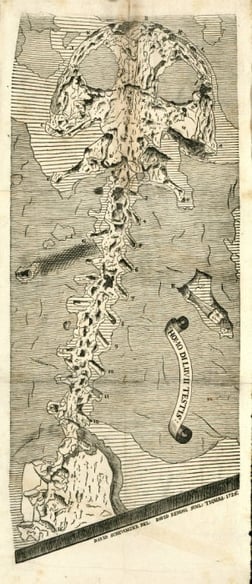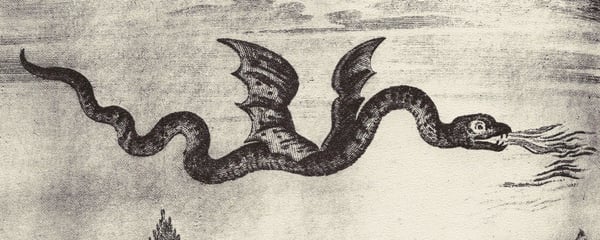By the time Johann Jakob Scheuchzer published the first volume of his momentous Physica Sacra in 1731, he was already a renowned scientist. Like many scholars of his age, Scheuchzer did not limit himself to only one field. Well versed in astronomy, he depicted one of the earliest known accounts of the Perseid meteor shower in 1709. That same year, Scheuchzer also published Herbarium Diluvianum ("Herbarium of the Deluge"), an exhaustive botanical reference consulted long into the following century. A colleague of Sir Isaac Newton and other luminaries of the early modern era, Scheuchzer is unfortunately often remembered not for his expansive body of work, but for his most famous mistake.
Documenting the Natural World
Scheuchzer spent almost a decade traveling through the Alps, and he published an account of his journey, Itinera alpina, in 1708. As he wandered through Switzerland, he encountered and documented not only the natural world, but also the superstitions of local residents. People told stories of lizards with multiple tails and snakes with human faces. Scheuchzer investigated the supposed remains of a fire-breathing dragon ("draconum alatum", pictured below) and concluded, "these are nothing more than the remains of a bear, which may have had his winter accommodation in the cave, and because of the collapse of the entrance must have died by starvation."
Scheuchzer continues, however, on a less skeptical note: "However I assume that by comparison with the dragons from the Swiss and foreign [countries] that such animals exist; they would be a rare species of animals, or as many say, deformed snakes, because not all are the same kind. Some have wings, others are without limbs."
Reconciling Science with Religion
Scheuchzer's body of work aptly illustrates the tension between science and religion in the eighteenth century. Verily overwhelmed with discoveries about the natural world, scholars struggled to reconcile their findings with religious doctrine. Scheuchzer was no exception. He first considered fossils to be formed through the introduction of some kind of petrifying juice. But then he read John Woodward's An Essay toward a Natural History of the Earth and Terrestrial Bodies, especially Minerals (1695), in which Woodward argues that fossils are evidence of the great flood detailed in the Old Testament. Scheuchzer was so enthralled with Woodward's theories, he took it upon himself to translate them into Latin, then the chosen language of scientists. Scheuchzer's translation brought Woodward to a much wider audience, and the theory began to take hold.
Scheuchzer subsequently published his own works to corroborate Woodward's theory. In 1708, he published Piscium Querelae et Vindiciae ("Complaints and Claims of the Fishes"), a pamphlet detailing the grievances of the fish killed in the flood. And Scheuchzer intended Herbarium Diluvianum to be a catalogue of plants rendered extinct by the flood. In 1716, Scheuchzer also published Museum Diluvianum ("Museum of the Flood"), a catalogue of the fossils in his own extensive collection.
Scheuchzer's Confounding Discovery
 In 1725, Scheuchzer believed that he'd discovered a critical piece of evidence, definitively proving Woodward's theory. Just outside Oeningen, Germany, Scheuchzer found fossilized remains of an unidentified vertebrate (pictured at right). He believed they were the remains of a person drowned during the flood, and he included the finding in his 1726 Lithographia Helvetica. Naturally, Scheuchzer named it Homo diluvii testis. The meter-long skeleton struck many experts as too small to be hominid, but no one could authoritatively rule out the possibility at the time.
In 1725, Scheuchzer believed that he'd discovered a critical piece of evidence, definitively proving Woodward's theory. Just outside Oeningen, Germany, Scheuchzer found fossilized remains of an unidentified vertebrate (pictured at right). He believed they were the remains of a person drowned during the flood, and he included the finding in his 1726 Lithographia Helvetica. Naturally, Scheuchzer named it Homo diluvii testis. The meter-long skeleton struck many experts as too small to be hominid, but no one could authoritatively rule out the possibility at the time.
Scheuchzer would go on to publish the Physica Sacra (1731-1735) in four intricately illustrated volumes. Also known as the Kupfer-Bibel, the work details Scheuchzer's theory of natural theology. He uses the natural world to illustrate the magnificence of God. This is not to say that Scheuchzer accepted scripture unquestioningly. Regarding the Tower of Babel, Scheuchzer notes that it could not have actually reached the heavens because a tower of that height would have required more building materials than could be extracted from the earth. Furthermore, he calculated that such an edifice would require twelve years of labor from precisely 1,763,128 workers—one-fifth of the world's population at the time.
Meanwhile, Scheucher's identification of Homo diluvii testi had fallen into question and remained a contentious topic in the scientific community even after Scheuchzer died in 1733. In 1758, Swiss naturalist Johannes Gessner suggested that the fossil was in fact that of a large fish. It was not until 1811 that the matter was finally settled; Georges Cuvier cleaned the specimen and ruled it a giant salamander. We now know that the fossil dates from the Miocene era.
In 1831, Friedrich Holl named the salamander Salamandra scheuchzeri, after the great scientist who unearthed it. The species' name was changed six years later to Andrias scheuchzeri, the name it still bears today. Like Scheuchzer's Physica Sacra and his other works, this salamander's name lives on as a testament to a truly brilliant career.










